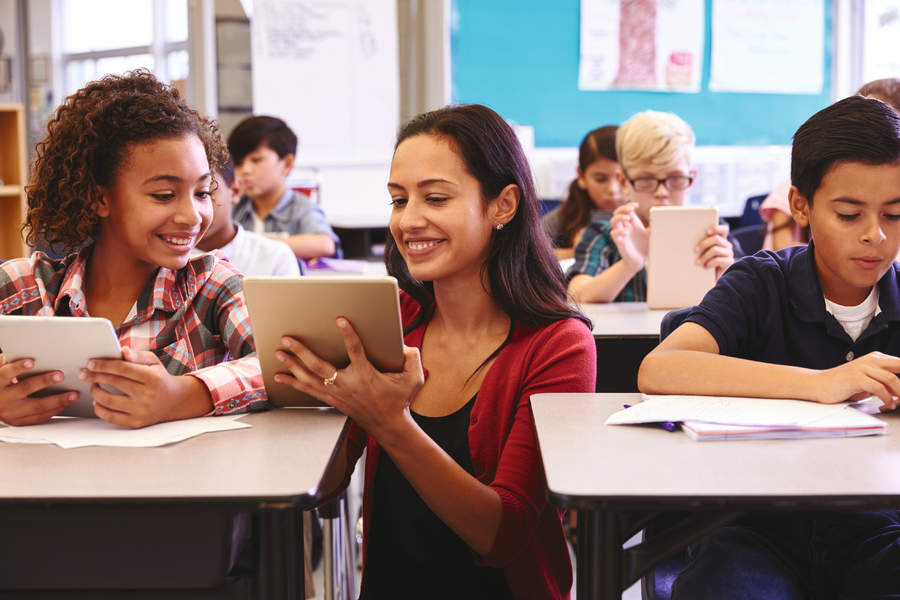Promoting Social-Emotional Learning in Digital Life
Social-emotional learning continues to be a key aspect of digital citizenship

Technology is changing the social-emotional learning landscape that all students navigate every day, from how they express themselves to how they communicate with friends and family. How educators support all students, regardless of language or ability, to promote their own well-being and be a positive influence online, continues to be a priority for all school districts.
And in light of the pandemic, that SEL piece of digital citizenship has become even more critical.
“Even though students are back in the classroom and it’s supposed to be back to normal, it doesn’t quite feel like that,” said Tali Horowitz, New York education director for Common Sense, during a session of the recent New York City Department of Education Beyond Access virtual professional development conference. “It’s been a rough year for all of us. We may have lost people close to us, our students may have, and there’s a lot going on.”
Accordingly, much of the focus in schools has been on social-emotional learning. “Much of that is around soft skills, not core content,” said Jackie Patanio, edtech citywide lead, NYCDOE. “Not things you need to know for math, right, but soft skills on how to interact with one another and build those skills internally, so you can build a relationship with someone and learn how to empathize with them.”
Resources, lessons, best practices, and activities to help boost SEL in digital citizenship were the focus of the discussion during the session, which can be viewed free on demand here.
Common Sense Education has also created a resource center full of free resources for promoting SEL in the digital lives of students.
Social-Emotional Learning & Digital Citizenship Takeaways
Taking stock. To help support SEL and connect with students and families, teachers may want to consider focusing on specific key areas with the help of these questions from ShareMyLesson:
Tech & Learning Newsletter
Tools and ideas to transform education. Sign up below.
- Experiences: What losses or significant changes has your child experienced during the COVID-19 pandemic?
- Feelings: How has your child handled being out of school, away from their friends, and sheltered in place with your family?
- Anticipation: What has been your child’s reaction when they knew they were coming back to school?
- Behavior: Is there anything else about your child’s behavior during the pandemic that you think will help us help them take full advantage of their time with us?
- Consider adding: How can the school support you? OR What could help your child have more success in school?
“Remember, this work should never be done alone,” said Laura Ogando, program manager for Digital Literacy & Inclusion, NYCDOE. “When we’re working on these topics, we need to connect to the support community, and involve our social workers, guidance counselors, school psychologists -- there’s an array of folks in the building.”
During the pandemic, social media was cited by students as important for keeping connected to family and friends, staying informed about current events, and getting information about COVID-19, according to research by Common Sense.
In addition, there’s been a marked increase in hate speech online, and learning to navigate all this is an essential part of good digital citizenship. “It’s important to teach our students how to be upstanders,” Horowitz said. “How do they address and report people when they see this kind of hate speech, and how do they handle it when it’s hitting themselves as well.”
SEL and digital citizenship lessons. Common Sense Education offers a plethora of free, vetted SEL-focused lessons.
“The beauty of these activities is that a lot are quick, 15-minute activities, which is great when you need to address something but don’t want to take up an hour,” Ogando said. “It’s all just very practical. These lessons are not necessarily bounded by grade. Some students may not have gotten these lessons when they were younger.”
Many Common Sense lessons start with self, and then go to responsible decision-making, and then finally widens out into social awareness.
Different lessons that span across various grade bands are available. For example, during the presentation, one lesson on self-management was shared. It focuses on teaching children to say goodbye to technology by developing a three-step routine consisting of pausing, breathing, and finishing up. Act out scenarios are partnered with the lessons to help students learn to use the lessons, and space is also provided for students to reflect on the lesson.
Another lesson that was shared focuses on being a “super” digital citizen who makes sure other students make good choices and are safe, responsible, and respectful. Other shared lessons explored digital “drama” and considering other peoples’ perspectives as well as dealing with online and digital relationships.
Every lesson also has a family conversation piece and is available in Spanish. “It’s a good opportunity for families to share their thoughts and ideas around these topics as well,” Horowitz said.
Finding what works best. To help lower stress and prevent online burnout, it’s important to remind students that they can put conversations on mute, turning off notifications or stepping back before responding. Or that they can even disconnect completely by putting down their device and just going outside.
“We’re working to help our students find what works best for them versus what the tech company says works best for them,” Horowitz said.
Ray Bendici is the Managing Editor of Tech & Learning and Tech & Learning University. He is an award-winning journalist/editor, with more than 20 years of experience, including a specific focus on education.
